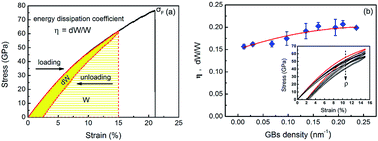Energy dissipation in mechanical loading of nano-grained graphene sheets
Abstract
A molecular dynamics (MD) simulation illustrates that different from single-crystal graphene sheets, the loading and unloading stress–strain curves of nanocrystalline ones do not coincide with each other, indicating substantial energy dissipation due to irreversible structural changes in the grain boundaries. An energy dissipation coefficient is proposed to quantitatively describe the effects of the grain size, temperature and strain rate dependent irreversible breaking and reforming of bonds in GBs, realignment of grain orientation, lattice-shearing-induced phase transformation, and formation of Stone–Wales defects and vacancies near GBs. The energy dissipation coefficient increases as the grain size decreases, especially at high temperature and low strain rate, and consequently, the reversibility of nanocrystalline graphene sheets under mechanical loading deteriorates compared to single-crystal graphene.


 Please wait while we load your content...
Please wait while we load your content...